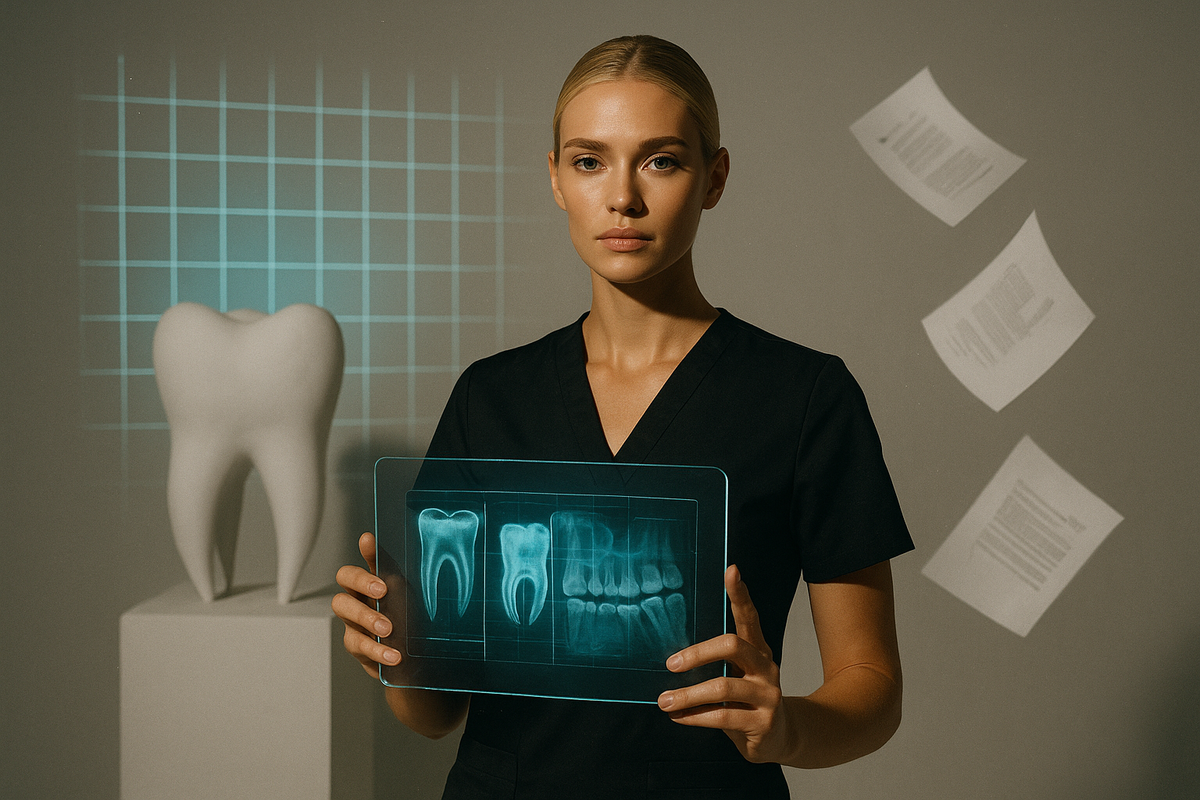The Future is Now: Integrating Artificial Intelligence in Dentistry
Dentistry is entering a new era, one where artificial intelligence is reshaping diagnostics, patient care, and practice efficiency. From enhancing radiographic analysis to expanding access through teledentistry and mobile care, AI offers transformative potential for both providers and patients.

By Krisa Swanson, RDH
As we stand on the cusp of 2024, the landscape of dentistry is undergoing a transformative shift propelled by the rapid integration of technology—particularly artificial intelligence (AI). Traditional methods of patient care are evolving, and modern dental professionals must recognize the immense potential that AI brings to the forefront.
This article explores the exciting future of dentistry and how AI is reshaping the way we care for patients, offering a glimpse into vast new possibilities.
Dentistry Meets Innovation
Historically, dentistry has been rooted in manual processes and the expertise of practitioners, with limited investment in innovation. AI is now ushering in a new era—one where technology seamlessly collaborates with human expertise. More than ever, it is critical for dental professionals to understand, acknowledge, and embrace this change as they strategically plan for the future.
Diagnostic Assistance
Many studies have advanced AI in dentistry, particularly through convolutional neural networks (CNNs) and artificial neural networks (ANNs). While traditional radiography provides valuable insights, AI takes diagnostics further—analyzing and comparing images with unmatched precision.
AI can help detect dental caries, calculus, and alveolar bone loss, and in the near future, may even enable definitive diagnoses of root abnormalities and oral cancer. By sifting through vast amounts of data, AI identifies patterns and anomalies that human eyes might overlook, improving diagnostic accuracy and enabling earlier detection of disease.
As we step into 2024, incorporating AI into imaging is not just a technological leap but a commitment to providing patients with the highest standard of care (Khanagar et al., 2021).
Teledentistry and Mobile Dentistry
According to the World Health Organization (WHO), an estimated 2.5 billion people suffer from untreated dental caries (WHO, 2022). This staggering statistic reflects a lack of access to care in many communities.
Teledentistry offers a newer approach—using technology for screening and diagnosing when in-person care is not available (ADA, 2022). Patients can upload images into AI systems, which generate evaluations and treatment recommendations from local teledentists.
AI-driven mobile dentistry is the next step. By reaching underserved populations, providers can reduce decay rates and improve health outcomes, making a meaningful difference in countless lives (The Teledentists, 2023).
Efficiency in the Practice
From a consulting perspective, AI brings multiple advantages:
- Improved productivity
- Increased case acceptance
- Enhanced continuity of care between clinicians
For new hygienists, AI assists with co-diagnosis, boosting confidence and precision—while also creating financial benefits for the practice. Insurance reimbursement can also improve through better-supported documentation.
AI further streamlines practice management by analyzing metrics, uncovering growth opportunities, and reducing time spent printing and reviewing reports. By saving time and identifying missed opportunities, AI empowers practices to work smarter, not harder.
Patient Education
AI also enhances patient engagement. Interactive tools allow patients to visualize their conditions, better understand diagnoses, and take ownership of their oral health.
Education on the oral-systemic link is particularly impactful, improving compliance while strengthening the provider–patient relationship. Patients who feel more informed are more likely to remain loyal and proactive in their care.
Custom-Made Treatment Planning
Machine learning allows AI to adapt to patient-specific patterns, empowering professionals to create highly personalized treatment plans.
By analyzing oral health history, lifestyle factors, and genetic predispositions, AI recommends preventive and therapeutic strategies tailored to each individual. This personalized care model prioritizes outcomes, satisfaction, and overall well-being—aligning dentistry with a truly patient-centric future.
Administrative Tasks
AI is also streamlining administrative processes, automating repetitive tasks while reducing human error. Far from replacing staff, AI frees up valuable time so professionals can focus more on patient care.
From scheduling to billing, automation enhances overall efficiency and ensures practices keep pace with evolving demands.
Communication Lines
AI-powered chatbots can now provide real-time responses to patient queries, strengthening communication and fostering trust.
Still, challenges remain. Privacy, data security, and ethical considerations must remain top priorities when implementing AI. Dental professionals must follow ethical guidelines and data protection regulations while also investing in ongoing training to fully harness AI’s capabilities.
The Takeaway
Dentistry now stands at a crossroads: embrace AI or risk falling behind. The potential benefits are vast—from improved diagnostic accuracy to personalized treatment planning, patient education, and operational efficiency.
Dental professionals who strategically integrate AI into their practices will not only stay ahead but also contribute to the ongoing evolution of dentistry.
The future is here. It is time to harness artificial intelligence to improve oral healthcare.
Check out Krisa’s blog:
👉 Strategic Scheduling and Planning for 2024
References
- Khanager S, Al-Ehaideb A, et al. Developments, application, and performance of artificial intelligence in dentistry – A systematic review. J Dent Sci. 2021;16(1):508–522.
- World Health Organization (2022). Launch of the Global Oral Health Status Report. Retrieved from WHO.org
- American Dental Association (2022). Overview of Artificial and Augmented Intelligence Uses in Dentistry.
- The Teledentists (2023). AI Evaluations. Retrieved from theteledentists.com




